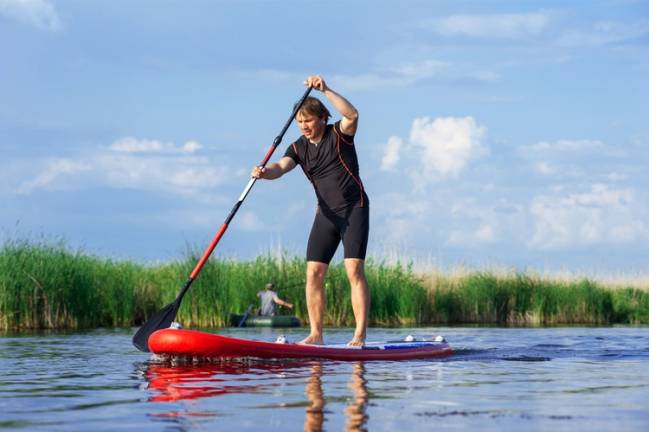Is stand-up paddleboarding good exercise?

Stand-up paddleboarding (SUP) is a fun alternative to traditional cardiovascular endurance sports like jogging, biking, and swimming. Many people may find paddleboarding more accommodating than running or walking because it's a low-impact sport. It's also suitable for all ages, and for people with lower-body orthopedic problems that inhibit them from running or even walking comfortably.
SUP originates from modes of transport used by ancient cultures in Africa and South America and made its way to Southern California by way of the Hawaiian Islands in the early 2000s. Since then, the sport has spread across the country. In addition to its growing popularity on the coasts, it’s not unusual to see packs of paddleboarders traversing rivers. And there are festivals, races, and professional competitions helping to expand the sport's popularity.
But is it a good workout? The nonprofit American Council on Exercise enlisted researchers to find out. They studied whether paddleboarding increased muscle strength, conditioned the core, enhanced balance, and improved cardiorespiratory fitness. The core workout comes from the constant need to maintain balance on an ever-shifting surface by contracting the abdominal and other core muscles.
Paddle with intent
Novice paddlers did not achieve an adequate heart rate for standup paddleboarding to qualify as a moderate-intensity exercise, the researchers found. But that may be because study participants were told to paddle at a “leisurely pace” and were perhaps a bit cautious.
“Their limitations may have been as much about skill level and comfort as about fitness," said Jeanne Nichols, Ph.D., of the University of California, San Diego, who was part of the research team.
The lead researcher, John Porcari, Ph.D., at the University of Wisconsin, La Crosse, agreed.
"The more proficient you are on the water — or in any type of workout, for that matter — the better the workout you will get," he said.
Get moving, get outside
Both researchers say there's great value in leisurely exercise and in getting outdoors. But if you are using SUP to get a good workout, they say, you have to paddle with intent.
The study found that SUP strengthens the erector spinae — the muscles and tendons that run along both sides of the spine — and the abdominal muscles. Porcari said that when paddlers increased their intensity, they did more twisting, which indicates good form.
“The ability to turn the shoulders and really dig in to create torso rotation creates more power in the paddle stroke and better recruitment of the external obliques," he said. The external obliques are the side abdominal muscles that help rotate the trunk.
Most importantly, though, the researchers said their subjects found standup paddleboarding to be lots of fun — and finding enjoyable activities can be a driving force in adhering long-term to a true lifestyle change.
For the full study, visit the American Council on Exercise at acefitness.org.